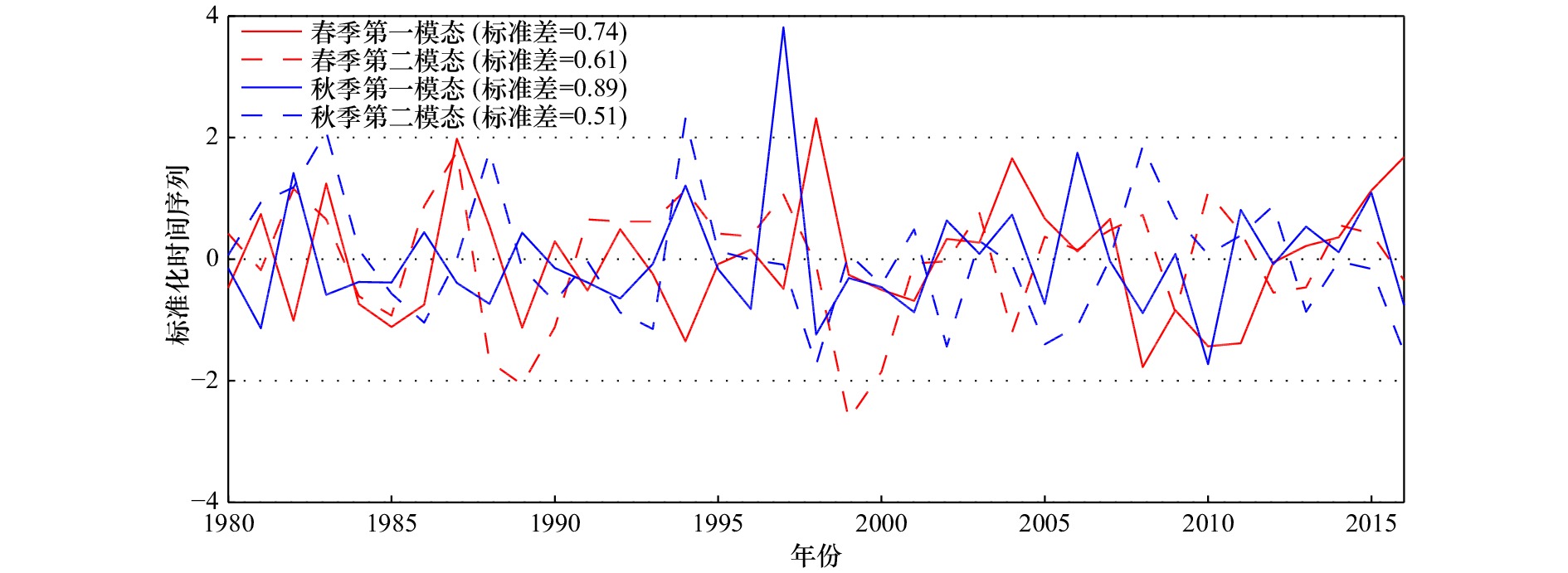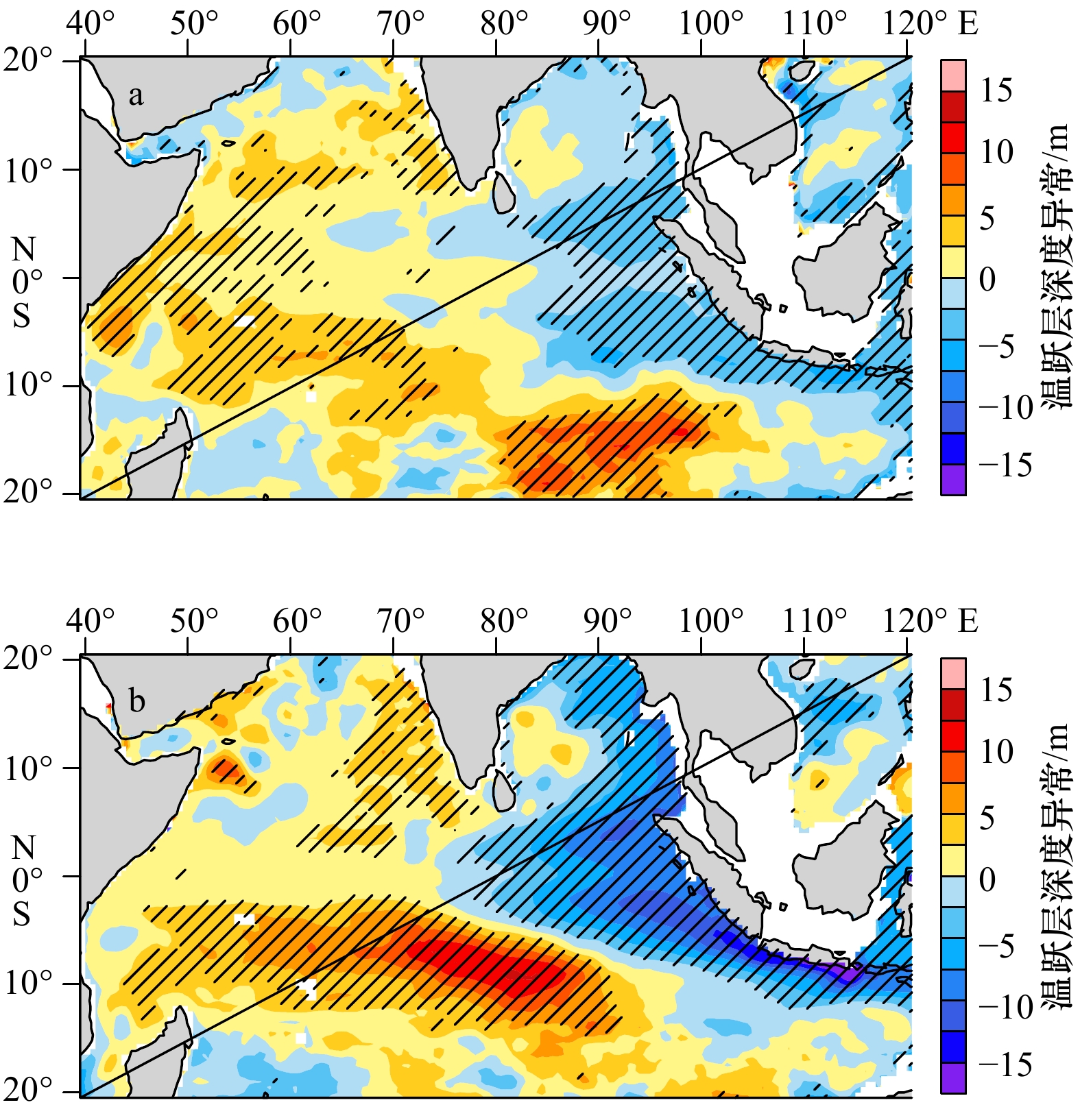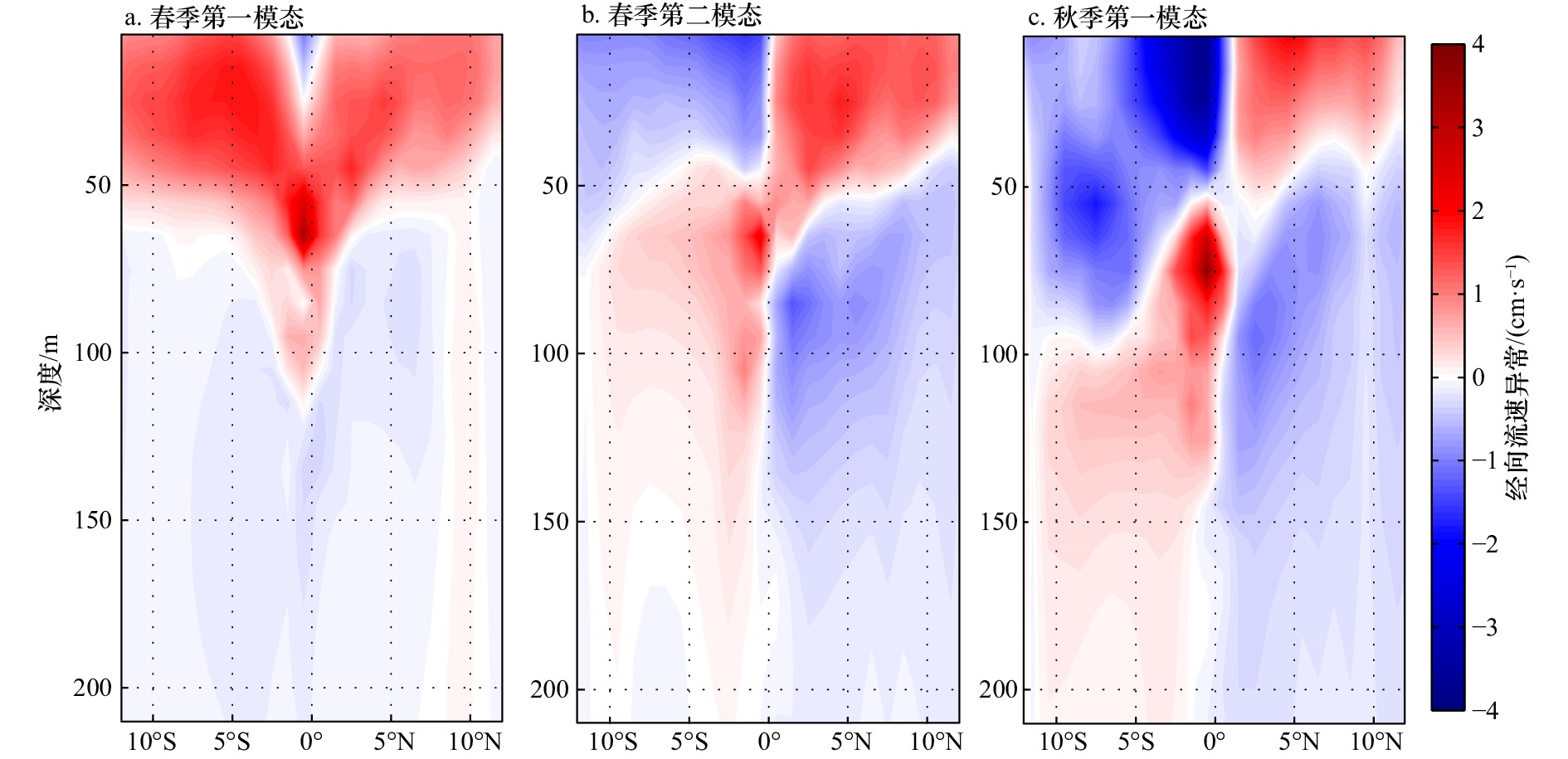Interannual variability of meridional heat transport and its mechanism in the Indian Ocean during monsoon transitions
-
摘要: 本文采用SODA3.4.2再分析数据和POP2海洋模式研究了季风转换期间(春季和秋季)热带印度洋经向热输运异常(Meridional Heat Transport Anomaly, MHTA)的年际变异特征。春季MHTA存在两个主要模态,即一致模态和辐合辐散模态:一致模态表现为热带印度洋上层一致的向北输运,受热带印度洋海温一致模相关的赤道反对称风场(赤道以北/南为东北风/西北风异常)调控;辐合辐散模态则呈现关于赤道对称的表层辐散次表层辐合特征,受控于赤道以南的热带西南印度洋和副热带东南印度洋海温偶极子。然而,秋季MHTA仅表现为辐合辐散模态,受到印度洋偶极子期间赤道东风和赤道外反气旋式风应力异常影响。此外,POP2敏感性试验也验证了印度洋海温模态影响下异常风场对MHTA的调控作用,即反对称的风引起一致向北的MHTA,赤道东风异常引起MHTA表层辐散、次表层辐合现象。因此,热带印度洋海气耦合模态年际变化对印度洋上层热量再分配有着重要的意义。Abstract: Interannual variability of meridional heat transport anomaly (MHTA) in the tropical Indian Ocean (IO) during monsoon transitions (boreal spring and autumn) is investigated based on SODA3.4.2 and POP2 results. There exist two leading interannual modes in spring, namely the consistent mode and the divergence and convergence (div/conv) mode. The consistent mode characterized by the northward MHTA in the upper IO, is controlled by the antisymmetric wind structures with northeasterlies anomalous northeasterlies (northwesterlies) to north (south) of the equator. However, the spring div/conv mode is featured by the meridional divergence in the surface layer and convergence in the subsurface layer on both side of the equator. Such a mode is modulated by the sea surface temperature anomaly (SSTA) dipole in the tropical southwestern IO and subtropical southeastern IO south of the equator. In autumn, the div/conv mode is dominated by the IOD-induced equatorial easterlies and associated anticyclonic wind stress anomalies in the off-equatorial regions. The POP2 model sensitivity experiments confirm the roles of anomalous winds induced by the Indian Ocean SSTA modes in modulating the MHTA, that is, the antisymmetric winds induce northward MHTA, while the anomalous easterly winds lead to the div/conv pattern. Therefore, the interannual variability of air-sea coupled modes in the IO plays a vital role in the basin-scale and hemispheric-scale heat exchanges.
-
图 3 径向热输运异常分解项分别回归春季和秋季经向热输运异常对应的NPCs
a, d, g 分别由${v}'\overline{T}$项(vatm)、$\overline{v}{T}'$项(vmta)和${v}'{T}'$项(vata)导致的春季MHTA回归春季第一模态NPC;b, e, h. 与a, d, g类似,只是用春季MHTA分解项回归春季第二模态NPC;c, f, i. 与a, d, g类似,只是用秋季MHTA分解项回归秋季第一模态NPC
Fig. 3 Decomposition terms of meridional heat transport anomaly regressed onto spring and autumn meridional heat transport anomaly NPCs
a, d, g are the MHTA induced by the ${v}'\overline{T}$ (vatm), $\overline{v}{T}'$ (vmta) and ${v}'{T}'$ (vata) term regressed onto spring NPC1; b, e, h. same as a, d, g, but regressed onto spring NPC2; c, f, i. same as a, d, g, but regressed onto autumn NPC1
图 4 春季海表面风应力异常(单位:N/m2)和海表面温度异常(SSTA)分别回归春季一致模态(a)和辐合辐散模态(b)所对应的NPC1和NPC2;秋季海表面风应力异常和SSTA回归秋季辐合辐散模态所对应的NPC1(c)
打点区域SSTA超过90%信度检验,黑色矢量箭头超过90%信度检验
Fig. 4 Spring wind stress anomalies (unit: N/m2) and sea surface temperature anomaly (SSTA) regressed onto spring NPC1 (a) and NPC2 (b), respectively; autumn wind stress anomalies and SSTA regressed onto autumn NPC1 (c)
The white dotted areas represent SSTA regression is exceeding 90% significance level. The black wind vectors represent wind field regression is exceeding 90% significance level
图 6 春季MHTA回归标准化的春季IOB指数(a)和春季纬向海温异常偶极子指数(b),秋季MHTA回归标准化的秋季DMI指数(c)
阴影区域MHT异常超过90%信度检验
Fig. 6 Spring MHTA (units: PW) regressed onto the spring IOB index (a) and SSTA dipole mode index (b), respectively. Autumn MHTA regressed onto the autumn DMI index (c)
Shaded areas represent the regression is exceeding 90% significance level
图 7 POP2模式经向流速在不同风场强迫下的响应
a. EXP-MAM1敏感性试验与春季控制试验之差;b. EXP-MAM2敏感性试验与春季控制试验之差;c. EXP-SON1敏感性试验与秋季控制试验之差
Fig. 7 Meridional velocity anomalies in response to different wind forcings based on POP2 results
a. Difference between EXP-MAM1 and spring CON; b. difference between EXP-MAM2 and spring CON; c. difference between EXP-SON1 and autumn CON
-
[1] Levitus S, Antonov J I, Boyer T P, et al. Warming of the world ocean[J]. Science, 2000, 287(5461): 2225−2229. doi: 10.1126/science.287.5461.2225 [2] Cheng Lijing, Trenberth K E, Fasullo J, et al. Improved estimates of ocean heat content from 1960 to 2015[J]. Science Advances, 2017, 3(3): e1601545. doi: 10.1126/sciadv.1601545 [3] Carissimo B C, Oort A H, Vonder Haar T H. Estimating the meridional energy transports in the atmosphere and ocean[J]. Journal of Physical Oceanography, 1985, 15(1): 82−91. doi: 10.1175/1520-0485(1985)015<0082:ETMETI>2.0.CO;2 [4] Trenberth K E, Solomon A. The global Heat balance: Heat transports in the atmosphere and ocean[J]. Climate Dynamics, 1994, 10(3): 107−134. doi: 10.1007/BF00210625 [5] Yu Lisan, Jin Xiangze, Weller R A. Annual, seasonal, and interannual variability of air-sea heat fluxes in the Indian Ocean[J]. Journal of Climate, 2007, 20(13): 3190−3209. doi: 10.1175/JCLI4163.1 [6] Han Weiqing, Vialard J, McPhaden M J, et al. Indian Ocean decadal variability: A review[J]. Bulletin of the American Meteorological Society, 2014, 95(11): 1679−1703. doi: 10.1175/BAMS-D-13-00028.1 [7] Oberhuber J M. The budgets of heat, buoyancy and turbulence kinetic energy at the surface of the global ocean[R]. Max-Planck Institute fur Meteorologie Report 15, 1988. [8] Schoenefeldt R, Schott F A. Decadal variability of the Indian Ocean cross-equatorial exchange in SODA[J]. Geophysical Research Letters, 2006, 33(8): L08602. [9] Garternicht U, Schott F. Heat fluxes of the Indian Ocean from a global eddy-resolving model[J]. Journal of Geophysical Research: Oceans, 1997, 102(C9): 21147−21159. doi: 10.1029/97JC01585 [10] Hastenrath S, Greischar L. The monsoonal heat budget of the hydrosphere-atmosphere system in the Indian Ocean sector[J]. Journal of Geophysical Research: Oceans, 1993, 98(C4): 6869−6881. doi: 10.1029/92JC02956 [11] Hsiung J, Newell R E, Houghtby T. The annual cycle of oceanic heat storage and oceanic meridional heat transport[J]. Quarterly Journal of the Royal Meteorological Society, 1989, 115(485): 1−28. doi: 10.1002/qj.49711548502 [12] Lee T, Marotzke J. Inferring meridional mass and heat transports of the Indian Ocean by fitting a general circulation model to climatological data[J]. Journal of Geophysical Research: Oceans, 1997, 102(C5): 10585−10602. doi: 10.1029/97JC00464 [13] Loschnigg J, Webster P J. A coupled ocean-atmosphere system of SST modulation for the Indian Ocean[J]. Journal of Climate, 2000, 13(19): 3342−3360. doi: 10.1175/1520-0442(2000)013<3342:ACOASO>2.0.CO;2 [14] Wacongne S, Pacanowski R. Seasonal heat transport in a primitive equations model of the tropical Indian Ocean[J]. Journal of Physical Oceanography, 1996, 26(12): 2666−2699. doi: 10.1175/1520-0485(1996)026<2666:SHTIAP>2.0.CO;2 [15] 吴方华, 李薇, 刘海龙, 等. 一个海洋环流模式模拟的北印度洋经向环流及其热输送[J]. 大气科学, 2008, 32(1): 14−26.Wu Fanghua, Li Wei, Liu Hailong, et al. Evaluation on seasonal circulation and heat transport simulated by LICOM in the northern Indian Ocean[J]. Chinese Journal of Atmospheric Sciences, 2008, 32(1): 14−26. [16] Chirokova G, Webster P J. Interannual variability of Indian Ocean heat transport[J]. Journal of Climate, 2006, 19(6): 1013−1031. doi: 10.1175/JCLI3676.1 [17] Jayne S R, Marotzke J. The dynamics of ocean heat transport variability[J]. Reviews of Geophysics, 2001, 39(3): 385−411. doi: 10.1029/2000RG000084 [18] Ma Jie, Feng Ming, Sloyan B M, et al. Pacific influences on the meridional temperature transport of the Indian Ocean[J]. Journal of Climate, 2019, 32(4): 1047−1061. doi: 10.1175/JCLI-D-18-0349.1 [19] 胡瑞金, 刘秦玉, 孟祥凤. 北印度洋的经向热输送与热收支的季节与年际变化[J]. 中国海洋大学学报, 2005, 35(3): 363−369.Hu Ruijin, Liu Qinyu, Meng Xiangfeng. The seasonal and interannual variabilities in the meridional heat transport and heat budget in the northern Indian Ocean[J]. Periodical of Ocean University of China, 2005, 35(3): 363−369. [20] 胡瑞金, 程传林. 冬、夏季印度洋越赤道经向翻转环流的年际变化[J]. 中国海洋大学学报, 2007, 37(2): 173−180.Hu Ruijin, Cheng Chuanlin. Interannual variability of the cross equatorial meridional overturning circulations in winter and summer for the Indian Ocean[J]. Periodical of Ocean University of China, 2007, 37(2): 173−180. [21] 郑佳瑜, 徐康, 陈更新, 等. 热带印度洋环流动力与季风相互作用研究进展[J]. 南京信息工程大学学报(自然科学版), 2018, 10(3): 275−281.Zheng Jiayu, Xu Kang, Chen Gengxin, et al. Research progress on the interaction between tropical Indian Ocean circulation dynamics and monsoon[J]. Journal of Nanjing University of Information Science and Technology (Natural Science Edition), 2018, 10(3): 275−281. [22] Meehl G A, Arblaster J M. The tropospheric biennial oscillation and Asian–Australian monsoon rainfall[J]. Journal of Climate, 2002, 15(7): 722−744. doi: 10.1175/1520-0442(2002)015<0722:TTBOAA>2.0.CO;2 [23] Pillai P A, Mohankumar K. Role of TBO and ENSO scale ocean-atmosphere interaction in the Indo-Pacific region on Asian summer monsoon variability[J]. Theoretical and Applied Climatology, 2009, 97(1/2): 99−108. [24] Webster P J, Clark C, Cherikova G, et al. The monsoon as a self-regulating coupled ocean-atmosphere system[J]. International Geophysics, 2002, 83: 198−219. [25] Webster P J, Moore A M, Loschnigg J P, et al. Coupled ocean-atmosphere dynamics in the Indian Ocean during 1997−98[J]. Nature, 1999, 401(6751): 356−360. doi: 10.1038/43848 [26] Loschnigg J, Meehl G A, Webster P J, et al. The Asian Monsoon, the tropospheric biennial oscillation, and the Indian Ocean Zonal Mode in the NCAR CSM[J]. Journal of Climate, 2003, 16(11): 1617−1642. doi: 10.1175/1520-0442(2003)016<1617:TAMTTB>2.0.CO;2 [27] Chirokova G Y. Interannual variability of the Indian Ocean heat transport and its correlations with climate modes[D]. Boulder: University of Colorado, 2010. [28] Sun Shuangwen, Fang Yue, Feng Lin, et al. Influence of the Indian Ocean dipole on the Indian Ocean meridional heat transport[J]. Journal of Marine Systems, 2014, 134: 81−88. doi: 10.1016/j.jmarsys.2014.02.013 [29] Li Chongyin, Mu Mingquan. The influence of the Indian Ocean dipole on atmospheric circulation and climate[J]. Advances in Atmospheric Sciences, 2001, 18(5): 831−843. doi: 10.1007/BF03403506 [30] 李崇银, 穆明权. 赤道印度洋海温偶极子型振荡及其气候影响[J]. 大气科学, 2001, 25(4): 433−443.Li Chongyin, Mu Mingquan. The dipole in the equatorial Indian Ocean and its impacts on climate[J]. Chinese Journal of Atmospheric Sciences, 2001, 25(4): 433−443. [31] 梁肇宁, 温之平, 吴丽姬. 印度洋海温异常和南海夏季风建立迟早的关系I. 耦合分析[J]. 大气科学, 2006, 30(4): 619−634.Liang Zhaoning, Wen Zhiping, Wu Liji. The relationship between the Indian Ocean sea surface temperature anomaly and the onset of South China Sea summer monsoon I. Coupling analysis[J]. Chinese Journal of Atmospheric Sciences, 2006, 30(4): 619−634. [32] 温之平, 梁肇宁, 吴丽姬. 印度洋海温异常和南海夏季风建立迟早的关系II. 机理分析[J]. 大气科学, 2006, 30(6): 1138−1146.Wen Zhiping, Liang Zhaoning, Wu Liji. The relationship between the Indian Ocean sea surface temperature anomaly and the onset of the South China Sea summer monsoon II. Analyses of mechanisms[J]. Chinese Journal of Atmospheric Sciences, 2006, 30(6): 1138−1146. [33] 黄刚, 胡开明, 屈侠, 等. 热带印度洋海温海盆一致模的变化规律及其对东亚夏季气候影响的回顾[J]. 大气科学, 2016, 40(1): 121−130.Huang Gang, Hu Kaiming, Qu Xia, et al. A review about Indian Ocean basin mode and its impacts on East Asian summer climate[J]. Chinese Journal of Atmospheric Sciences, 2016, 40(1): 121−130. [34] Cadet D L. The southern oscillation over the Indian Ocean[J]. Journal of Climatology, 1985, 5(2): 189−212. doi: 10.1002/joc.3370050206 [35] Klein S A, Soden B J, Lau N C. Remote sea surface temperature variations during ENSO: Evidence for a tropical atmospheric bridge[J]. Journal of Climate, 1999, 12(4): 917−932. doi: 10.1175/1520-0442(1999)012<0917:RSSTVD>2.0.CO;2 [36] Saji N H, Goswami B N, Vinayachandran P N, et al. A dipole mode in the tropical Indian Ocean[J]. Nature, 1999, 401(6751): 360−363. [37] Vinayachandran P N, Saji N H, Yamagata T. Response of the equatorial Indian Ocean to an unusual wind event during 1994[J]. Geophysical Research Letters, 1999, 26(11): 1613−1616. doi: 10.1029/1999GL900179 [38] Terray P, Sooraj K P, Masson S, et al. Anatomy of the Indian Summer Monsoon and ENSO relationships in state-of-the-art CGCMs: Role of the tropical Indian Ocean[J]. Climate Dynamics, 2021, 56: 329−356. doi: 10.1007/s00382-020-05484-z [39] Wang Bin, Wu Renguang, Fu Xiouhua. Pacific-East Asian teleconnection: How does ENSO affect East Asian climate?[J]. Journal of Climate, 2000, 13(9): 1517−1536. doi: 10.1175/1520-0442(2000)013<1517:PEATHD>2.0.CO;2 [40] Yang Jianling, Liu Qinyu, Xie Shangping, et al. Impact of the Indian Ocean SST basin mode on the Asian summer monsoon[J]. Geophysical Research Letters, 2007, 34(2): L02708. [41] Xie Shangping, Hu Kaiming, Hafner J, et al. Indian Ocean capacitor effect on Indo-Western Pacific climate during the summer following El Niño[J]. Journal of Climate, 2009, 22(3): 730−747. doi: 10.1175/2008JCLI2544.1 [42] Lau N C, Nath M J. Impact of ENSO on the variability of the Asian-Australian monsoons as simulated in GCM experiments[J]. Journal of Climate, 2000, 13(24): 4287−4309. doi: 10.1175/1520-0442(2000)013<4287:IOEOTV>2.0.CO;2 [43] Behera S K, Krishnan R, Yamagata T. Unusual ocean-atmosphere conditions in the tropical Indian Ocean during 1994[J]. Geophysical Research Letters, 1999, 26(19): 3001−3004. doi: 10.1029/1999GL010434 [44] Gadgil S, Vinayachandran P N, Francis P A, et al. Extremes of the Indian summer monsoon rainfall, ENSO and equatorial Indian Ocean oscillation[J]. Geophysical Research Letters, 2004, 31(12): L12213. [45] Ashok K, Guan Zhaoyong, Yamagata T. Impact of the Indian Ocean dipole on the relationship between the Indian monsoon rainfall and ENSO[J]. Geophysical Research Letters, 2001, 28(23): 4499−4502. doi: 10.1029/2001GL013294 [46] Ashok K, Guan Zhaoyong, Saji N H, et al. Individual and combined influences of ENSO and the Indian Ocean dipole on the Indian summer monsoon[J]. Journal of Climate, 2004, 17(16): 3141−3154. doi: 10.1175/1520-0442(2004)017<3141:IACIOE>2.0.CO;2 [47] Zhang Yazhou, Li Jianping, Xue Jiaqing, et al. The relative roles of the South China Sea summer monsoon and ENSO in the Indian Ocean dipole development[J]. Climate Dynamics, 2019, 53(11): 6665−6680. doi: 10.1007/s00382-019-04953-4 [48] Sharma S, Kumari A, Navajyoth M P, et al. Impact of air-sea interaction during two contrasting monsoon seasons[J]. Theoretical and Applied Climatology, 2020, 141(3): 1645−1659. [49] Krishnan R, Swapna P. Significant influence of the boreal summer monsoon flow on the Indian Ocean response during dipole events[J]. Journal of Climate, 2009, 22(21): 5611−5634. doi: 10.1175/2009JCLI2176.1 [50] Krishnan R, Sundaram S, Swapna P, et al. The crucial role of ocean-atmosphere coupling on the Indian monsoon anomalous response during dipole events[J]. Climate Dynamics, 2011, 37(1): 1−17. [51] Roose S, Joseph P V, Mohanakumar K. Changes in the temperature distribution in the top 150 m of the equatorial Indian Ocean in association with El Niño and monsoon drought[J]. International Journal of Climatology, 2019, 39(1): 31−42. doi: 10.1002/joc.5778 [52] Swapna P, Krishnan R. Equatorial undercurrents associated with Indian Ocean Dipole events during contrasting summer monsoons[J]. Geophysical Research Letters, 2008, 35(14): L14S04. [53] Zhang Yazhou, Li Jianping, Xue Jiaqing, et al. Impact of the South China Sea summer monsoon on the Indian Ocean dipole[J]. Journal of Climate, 2018, 31(16): 6557−6573. doi: 10.1175/JCLI-D-17-0815.1 [54] Carton J A, Chepurin G A, Chen Ligang. SODA3: A new ocean climate reanalysis[J]. Journal of Climate, 2018, 31(17): 6967−6983. doi: 10.1175/JCLI-D-18-0149.1 [55] Delworth T L, Rosati A, Anderson W, et al. Simulated climate and climate change in the GFDL CM2.5 high-resolution coupled climate model[J]. Journal of Climate, 2012, 25(8): 2755−2781. doi: 10.1175/JCLI-D-11-00316.1 [56] Dee D P, Uppala S M, Simmons A J, et al. The ERA-Interim reanalysis: Configuration and performance of the data assimilation system[J]. Quarterly Journal of the Royal Meteorological Society, 2011, 137(656): 553−597. doi: 10.1002/qj.828 [57] Carton J A, Penny S G, Kalnay E. Temperature and salinity variability in the SODA3, ECCO4r3, and ORAS5 ocean reanalyses, 1993−2015[J]. Journal of Climate, 2019, 32(8): 2277−2293. doi: 10.1175/JCLI-D-18-0605.1 [58] 郭文仪, 邱云, 林新宇. 孟加拉湾障碍层年际变化及其与印度洋偶极子事件的联系[J]. 海洋学报, 2020, 42(9): 38−49.Guo Wenyi, Qiu Yun, Lin Xinyu. The interannual variability of barrier layer in the Bay of Bengal and its relationship with IOD events[J]. Haiyang Xuebao, 2020, 42(9): 38−49. [59] Xiao Fuan, Wang Dongxiao, Leung M Y T. Early and extreme warming in the South China Sea during 2015/16: Role of an unusual Indian Ocean dipole event[J]. Geophysical Research Letters, 2020, 47(17): e2020GL089936. [60] Rayner N A, Parker D E, Horton E B, et al. Global analyses of sea surface temperature, sea ice, and night marine air temperature since the late nineteenth century[J]. Journal of Geophysical Research: Atmospheres, 2003, 108(D14): 4407. doi: 10.1029/2002JD002670 [61] Hersbach H, Bell B, Berrisford P, et al. The ERA5 global reanalysis[J]. Quarterly Journal of the Royal Meteorological Society, 2020, 146(730): 1999−2049. doi: 10.1002/qj.3803 [62] Hurrell J W, Holland M M, Gent P R, et al. The community earth system model: A framework for collaborative research[J]. Bulletin of the American Meteorological Society, 2013, 94(9): 1339−1360. doi: 10.1175/BAMS-D-12-00121.1 [63] Danabasoglu G, Bates S C, Briegleb B P, et al. The CCSM4 ocean component[J]. Journal of Climate, 2012, 25(5): 1361−1389. doi: 10.1175/JCLI-D-11-00091.1 [64] Smith R, Jones P, Briegleb B, et al. The Parallel Ocean Program (POP) reference manual: Ocean component of the Community Climate System Model (CCSM) and Community Earth System Model (CESM)[R]. Technical Report, LAUR-10-01853, Los Alamos National Laboratory, 2010. [65] Du Yan, Xie Shangping, Huang Gang, et al. Role of air-sea interaction in the long persistence of El Niño-Induced North Indian Ocean warming[J]. Journal of Climate, 2009, 22(8): 2023−2038. doi: 10.1175/2008JCLI2590.1 [66] Du Yan, Xie Shangping, Yang Yali, et al. Indian Ocean variability in the CMIP5 multimodel ensemble: The basin mode[J]. Journal of Climate, 2013, 26(18): 7240−7266. doi: 10.1175/JCLI-D-12-00678.1 -





 下载:
下载:






